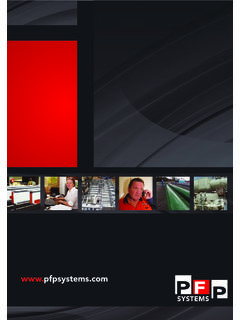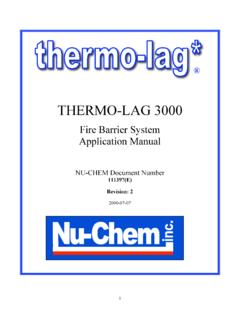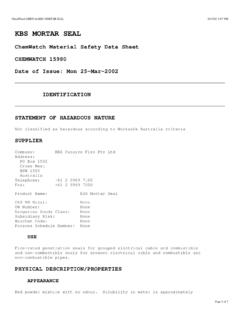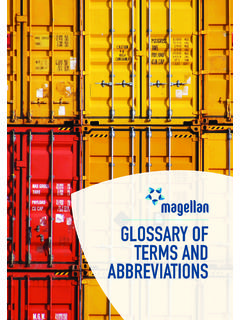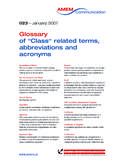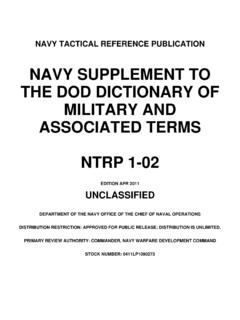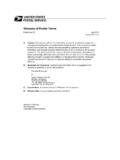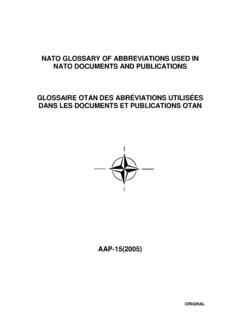Transcription of Interzinc 52 - Home » PFP Systems
1 A two component, metallic zinc rich epoxy primer which complies with the composition and performance requirements of SSPC Paint 20. PRODUCT DESCRIPTIONAs a high performance primer to give maximum protection as part of any anti-corrosive coating system for aggressive environments including those found on offshore structures, petrochemical facilities, pulp and paper plants, bridges and power 52 has been designed to provide excellent corrosion resistance in both maintenance and new construction situations. INTENDED USESBlue, Grey, GreenMatt 59% 50-75 microns (2-3 mils) dry equivalent to85-127 microns ( mils) wet m /litre at 75 microns and stated volume solids315 gallon at 3 mils and stated volume solids Allow appropriate loss factors Airless Spray, Air Spray, BrushPRACTICAL INFORMATION FOR Interzinc 52 ColourGloss LevelVolume SolidsTypical ThicknessTheoretical CoveragePractical CoverageMethod of ApplicationDrying TimeTemperature Touch DryHard DryMinimumMaximum See International Protective Coatings Definitions and AbbreviationsFor curing at low temperatures an alternative curing agent is available.
2 See Product Characteristics for overcoating intervals are shorter when using polysiloxane topcoats. Consult International Protective Coatings for further Interval withrecommended topcoats5 C (41 F) 2 hours10 hours8 hours Extended 15 C (59 F) 90 minutes6 hours4 hours Extended 25 C (77 F) 75 minutes4 hours3 hours Extended 40 C (104 F) 45 minutes2 hours2 hours Extended Base (Part A)29 C (84 F)Curing Agent (Part B)30 C (86 F)Mixed29 C (84 F) kg/l ( lb/gal) REGULATORY DATAF lash PointProduct WeightVOCSee Product Characteristics section for further lb/gal (336 g/l) USA - EPA Method 24156 g/kg EU Solvent Emissions Directive(Council Directive 1999/13/EC)
3 E p o x y Z i n c - R i c hInterzinc 52 Page 1 of 4 Epoxy Zinc-RichInterzinc 52 All surfaces to be coated should be clean, dry and free from contamination. Prior to paint application all surfaces should be assessed and treated in accordance with ISO 8504:2000. Oil or grease should be removed in accordance with SSPC-SP1 solvent cleaning. Abrasive Blast Cleaning Abrasive blast clean to Sa2 (ISO 8501-1:1988) or SSPC-SP6. If oxidation has occurred between blasting and application of Interzinc 52, the surface should be reblasted to the specified visual standard. Surface defects revealed by the blast cleaning process, should be ground, filled, or treated in the appropriate manner.
4 A surface profile of 40-75 microns ( mils) is recommended. Shop Primed Steelwork Interzinc 52 is suitable for application to unweathered steelwork freshly coated with zinc silicate shop primers. If the zinc shop primer shows extensive or widely scattered breakdown, or excessive zinc corrosion products, overall sweep blasting will be necessary. Other types of shop primer are not suitable for overcoating and will require complete removal by abrasive blast cleaning. Weld seams and damaged areas should be cleaned to a minimum St3 (ISO 8501:1988) or SSPC-SP3. Optimum performance will be achieved with blasting to Sa2 (ISO 8501-1:1988) or SSPC-SP6; where this is not practical, hand preparation to SSPC-SP11 is recommended.
5 SURFACE PREPARATIONM aterial is supplied in two containers as a unit. Always mix a complete unit in the proportions supplied. Once the unit has been mixed it must be used within the working pot life specified.(1) Agitate Base (Part A) with a power agitator.(2) Combine entire contents of Curing Agent (Part B) with Base(Part A) and mix thoroughly with power agitator. 4 part(s) : 1 part(s) by volume Suitable - small areas onlyTypically 50-75 microns ( mils) can be achievedNot recommended International GTA220(or International GTA415) International GTA822 Do not allow material to remain in hoses, gun or spray equipment. Thoroughly flush all equipment with International GTA822.
6 Once units of paint have been mixed they should not be resealed and it is advised that after prolonged stoppages work recommences with freshly mixed all equipment immediately after use with International GTA822. It is good working practice to periodically flush out spray equipment during the course of the working day. Frequency of cleaning will depend upon amount sprayed, temperature and elapsed time, including any delays. All surplus materials and empty containers should be disposed of in accordance with approrpriate regional not thin more than allowed by local environmental legislation(or International GTA415)RecommendedRecommendedGun DeVilbiss MBC or JGAAir Cap 704 or 765 Fluid Tip E Tip Range mm (17-21 thou)Total output fluid pressure at spray tip not less than 176 kg/cm (2503 )APPLICATIONM ixingMix RatioWorking Pot LifeAirless SprayAir Spray(Pressure Pot)BrushRollerThinnerCleanerWork StoppagesClean Up5 C (41 F) 15 C (59 F) 25 C (77 F) 40 C (104 F)
7 24 hours12 hours5 hours2 hoursPage 2 of 4 Epoxy Zinc-RichInterzinc 52In order to ensure good anti-corrosive performance, it is important to achieve a minimum dry film thickness of Interzinc 52 of 40 microns ( mils). To achieve a uniform, coalesced, closed film at this dry film thickness, it will be necessary to thin Interzinc 52 with 10% with International thinners. The film thickness of Interzinc 52 applied must be compatible with the blast profile achieved during surface preparation. Low film thickness should not be applied over coarse blast profiles. Care should be excercised to avoid the application of dry film thicknesses in excess of 150 microns (6 mils).
8 Care should be exercised to avoid over-application which may result in cohesive film failure with subsequent high builds, and to avoid dry spray which can lead to pinholing of subsequent coats. Over-application will also result in slower curing and extended handling and overcoating times. Over-application of Interzinc 52 will extend both the minimum overcoating periods and handling times, and may be detrimental to long term overcoating properties. When Interzinc 52 is allowed to weather before topcoating ensure all zinc salts are removed prior to paint application and only topcoat with recommended materials. Surface temperature must always be a minimum of 3 C (5 F) above dew point.
9 Interzinc 52 is not normally recommended for underwater use. Please consult International Protective Coatings for details in this situation. Interzinc 52 is suitable for the localised repair of damaged inorganic zinc primer - consult International Protective Coatings for specific advice. Low Temperature Curing An alternative curing agent is available for applications at temperatures less than 5 C (41 F). When using this alternative curing agent it should be noted that the VOC will increase to 360 g/l (3 lb/gal). Interzinc 52 is capable of curing at temperatures below 0 C (32 F). However, this product should not be applied at temperatures below 0 C (32 F) where there is a possibility of ice formation on the substrate.
10 Minimum overcoating intervalwith recommended topcoatsTemperature Touch Dry Hard Dry Minimum Maximum -5 C (23 F) 6 hours 32 hours 36 hours Extended*0 C (32 F) 3 hours 16 hours 18 hours Extended*5 C (41 F) 2 hours 6 hours 6 hours Extended* Touch dry times shown above are actual drying times due to chemical cure, rather than physical set due to solidification of the coating film at temperatures below 0 C (32 F) * See International Protective Coatings Definitions & Abbreviations For further details regarding cure times and overcoatability, please contact International Protective Coatings. This product has the following specification approvals: Steel Structures Painting Council - SSPC Paint 20 On consultation with International Protective Coatings this product is compatible with alternative application methods such as flow coating.


